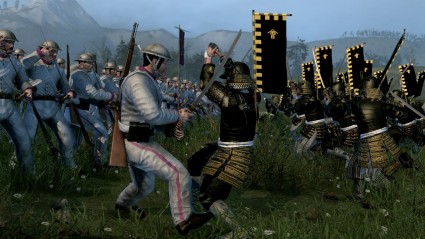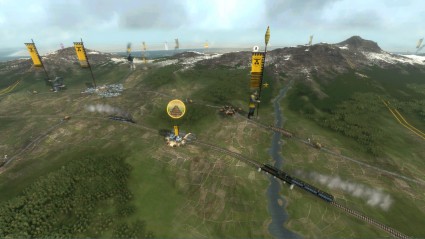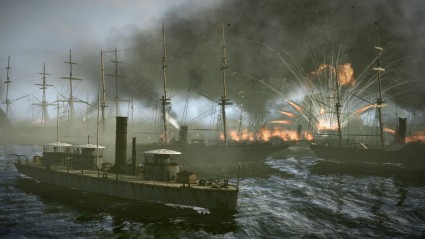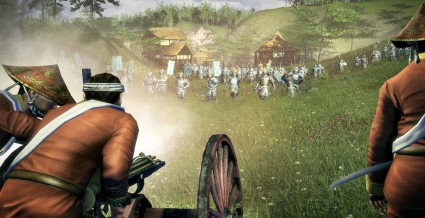Reviews
Total War: Shogun 2: Fall of the Samurai
March 16, 2012, Author: Michael Charge
Total War: Shogun 2 was a huge game. I’ve played through it and thoroughly enjoyed it, fighting my way across Japan to vie for position of the Shogun.
Now, Fall of the Samurai is taking us all back to Japan, only this time, guns and cannon are the name of the game. It is also perhaps the most exciting of Creative Assembly’s games, blending together both medieval-style units and firearms in a way that is almost perfect.
The Last Samurai… minus Tom Cruise
Fall of the Samurai is set in 1860’s and 1870’s Japan. The gates have opened and now trade with the west is ongoing, constantly introducing new ideas and new technology in terms of both industry and the military. However, civil war is on the horizon as the forces loyal to the Emperor square off against those supporting the Shoganate, to determine the future of Japan. Will the Shogun remain in control, or will the Emperor regain the overall political power?
The game does a great job of introducing you to the time period and telling you all the changes since you finished your Shogun 2 campaign. Most of these are done via the historical battles which are steadily unlocked, presenting the actual events in order and providing a series of challenging battles.

Something old, something new, something borrowed....
Unleash the Total War!
In terms of gameplay, Fall of the Samurai is an upgrade to Shogun 2. In the broadest sense it plays almost the same, with a campaign as well as naval and land battles that take place when the armies meet. However, the shift into the modern world (the original game being set in the 17th century) makes the gameplay a lot more like Empire and Napoleon, with lines of gun-equipped infantry ripping enemies to pieces.
First up, the campaign. 19th century Japan is a lot more detailed than its previous version. It is also a little larger, with a northern island being added because of the important role they play in this time period. Due to each turn being reduced to two weeks it feels massive, with the concept of a summer campaigning season and winter manoeuvring being much more upfront than in the previous game. This is compounded by the effects each season have, with winter decreasing an army’s movement and providing attrition to any army sat in hostile terrain, while spring gives you extra happiness as everyone celebrates the end of the snow.
Each of the six playable clans is part of a faction either pro-emperor or pro-shogun. This acts much like religion in the previous game, and ties all the various factions into two separate sides. These sides aren’t made of concrete, so you will at various points be fighting your own faction in your aim to unite Japan. All of the win conditions allow for faction victory so you don’t have to go on a mad invasion spree. You can also choose to make a Republic near the end of the game, which grants you some benefits but unites all the other clans against you. It’s a risk, but at least by that point in the game you do own most of the country anyway.
A key concept this expansion adds is modernisation. As you tech up, it adds to your clan development meter, which allows you to unlock more buildings, units and tech that brings you closer to becoming a nation on par with your British, French and American arms dealers/cash cows. This is a great thing if you wish to bring in the money or be able to stomp all over any opposing clan. Unfortunately, modernisation also brings in extra unhappiness as you stamp the traditions of your ancestors under foot while buying in rifles by the ton. This extra unhappiness can be countered in various ways, but when playing though the campaign I seemed to constantly be dealing with an angry population.

I like trains!
Modernisation does bring some benefits; the primary one being the railway system. You can now move your armies at high-speed between certain provinces as long as everyone along the line has built a railway system. This is great but does have limited effect, especially in the early game when none of the A.I. have built their stations. It also shapes your early expansion, as holding the stations means you can take your troops from one tip of the main island to the other; especially useful in the late stages of the game. I really like this inclusion, especially in co-op campaigns where human players realise the use of railways straight away and it turns into a game of railway robbery and sabotage.
In addition, the advent of modern naval guns means fleets play a much more important role on the campaign maps. In the previous games, fleets simply blockaded ports, transported armies or fought each other. Fall of the Samurai now allows them to be a bit more direct in their help; they can shell armies on the campaign map to harass them. This can be quite useful, especially when you’re trying to capture islands far away from the rest of your territory.
Even better; they can also use their artillery during the real-time battle scenes. The number and type of ships in fleet can affect the number of shells available, ranging from the tiny number a corvette can provide, up to several hundred per volley that most battleships churn out. If anything this is a little over-powered in terms of gameplay, but makes sense in terms of historical accuracy.
Land battles have also seen a huge change to the greater inclusion of line infantry and artillery, which harks back to Empire: Total War’s unit choice. This combination of old and new together gives the game a very unusual feeling; units are hugely more powerful, especially line infantry, and clashes are over much more quickly with battles being more decisive. I ran through the campaign primarily using blocks of line infantry and skirmishers with artillery, with tactics closer to Napoleon than the Samurai.
Sea battles have also been tweaked due to the shift to steam power as the primary mode of transport, removing the need to focus on mastering the wind or controlling oars. The change in ship technology also affects what the ships are made out of. Explosive rounds allow you to set any wooden-hulled ships you face on fire very quickly, but are useless against the later, iron-hulled craft for which you need armoured piercing. The coastal maps mean combat is pretty close quarters, but there is a lot more tactics and careful positioning, especially with the torpedo boats. Sea battles are actually rather fun.
Both the land battles and sea battles include a new direct control mode where you can aim both the ships’ weapons and artillery via the mouse. To be honest, this is a just a cool thing to mess around with; I don’t think I’d ever want to use it during the actual gameplay.
Fall of the Samurai’s gameplay is detailed and great fun to play no matter which mode you’re engaged in.

Smoke on the water
Beauty in battle
Total War has never slouched when it comes to the graphics and there is no change here. Shogun 2 already looked beautiful with the massed battles taking place over the hills, valleys and picturesque towns of Japan. Fall of the Samurai maintains this, except this time it has added explosions.
The campaign map is once again a joy to behold, with the background map shifted from a traditional Japanese style to a 19th century style, which is filled in inch-by-inch as it’s explored. When left idle, trains happily puff along the tracks, clouds drift across your view and your giant counters representing your agents and armies pose like Godzilla on a comeback tour. It shifts in front of your eyes while you sit there, the graphics tempting you in to carry on taking over.
In battle, the graphics are also up to task. At sea, waves rock your boats while burning ships start to collapse as the fire spreads. On land, firing lines are wreathed in gun smoke, and bullets are rendered as they whizz past charging enemy troops, making the effect of battles much more visceral. Close-quarters combat is well rendered, with soldiers squaring off against each other and actually fighting, parrying and thrusting before delivering the final blow. Unfortunately, Fall of the Samurai includes the blood mod that was available for Shogun 2, which I think is a little over the top. It’s bright red and, if the camera is close enough, will splat all over the screen; a little incongruent with the realistic warfare depicted elsewhere.
The only issue I have with the graphics is the system requirements. The game can be a hog at much higher detail levels, but looks perfectly fine when played on medium. It also crashed a couple of times while playing through it, mainly during the campaign. Luckily, it does have a pretty good autosave system, which has saved me from losing hours of progress.
I think I’m turning Japanese
Fall of the Samurai use many of the sound effects that Shogun 2 used in terms of unit sounds, especially for the traditional units. However, the more modern units sound awesome, from massed rifle fire to the chattering of the gatling gun. I also much prefer the new battle narrator who sounds more like an American advisor rather than the horror that was in Shogun 2.

Is that Tom Cruise over there?
The music is also great, with the victory tune quickly lodging itself in your head. It’s a nice blend of old and new with marching tunes matching up with the traditional Japanese melodies. The game is great to listen to and really sets the theme.
War with friends
Multiplayer has for a long time been a cornerstone of the Total War experience. Fall of the Samurai extends the features of Shogun 2, refining the new avatar system and updating it to the 19th century. The biggest change is the fact you can now have two separate avatars, so you can play the online while backing the two separate sides. There are also more costume parts and retainers to match up with the new setting. The battles are pretty balanced, although like the main game, line infantry is still the way to go.
However, my favourite segment of the multiplayer is the co-op campaign. It is still limited to only two players but when you start playing you soon learn why; it can take a very long time for one player to do his whole turn and a full game will take you about a week to play. It is exceptionally good fun but I can only recommend playing it with friends or people you want to spend a long time with.
Fall of the Samurai is an expansion to the base game but doesn’t actually require Shogun 2 in order to work. It shows up in the main game as an additional campaign alongside the main one. In fact, if you own all the DLC, the game presents you with a full picture of Japanese history from the start of the Samurai until its decline.
The rise or fall is up to you!
I much preferred the Empire generation of games with their focus on newer tactics. Fall of the Samurai has brought that love to a much more detailed game, with the smaller time scale bringing a higher level of interaction in the world than before. However, the game also contains plenty of units for a more traditional player, granting more variety than I think we have ever seen in a Total War game.
Fall of the Samurai is well worth a play if you enjoy the Total War style of gameplay, while the history that the game is bursting with makes it a great teaching tool. It’s also going to last you a very long time. Worth every penny.
Platforms: PC | Tagged campaigns, Computer, Fall of the Samurai, PC, real time strategy, RTS, Sega, Shogun 2, Steam, Strategy, The Creative Assembly, Total War



